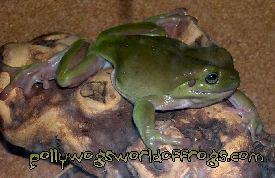Building a Rainchamber to breed your Frogs
If you are considering becoming an avid breeder of frogs, you will need a rainchamber for most species. A rainchamber is a necessary tool which will help to induce the breeding cycle in the colony you have prepared in advance. The time to make the rainchamber is while the frogs are in the "cooling" or "drier" cycle, so it will be ready when it is over.A separate tank?
If you have a vivarium that contains a layered gravel and soil floor, a pool, waterfall, etc. the idea of using a separate tank for the rainchamber is a good one. If you have more than one vivarium containing frogs you will want to breed in the future, the reasons for a separate tank becomes even more apparent. The Rainchamber has one purpose. It simulates the monsoonal or seasonal rains of the frogs' natural homeland, and puts them 'in the mood' to reproduce. The large amounts of water that are needed to create this effect could well destroy your vivarium set-up by flooding and dislodging plants, and even cause fungal infections in the frogs. Even if your frogs are aquatics, the rainchamber is a good idea. It will keep the egg masses out of the main tank and away from the adults, making it easier for you to remove and care for them.
The Frog Colony
To prepare the colony for this event,
 at the end of the cycle, begin by spray-misting them in normal vivariums, and increase
the amounts daily. Follow all advice listed in paragraph
at the end of the cycle, begin by spray-misting them in normal vivariums, and increase
the amounts daily. Follow all advice listed in paragraph  on that clickable link. Do not
take the misting to the point where you begin to smell rotting plant
material, you have then over soaked the soil and the plants will
eventually die.
However, this misting should induce the males to begin croaking. At the most, the
development of their nuptial pads
on front hands should also follow. They may even
become territorial.The introduction to the Rainchamber needs to be quick at this
point.
on that clickable link. Do not
take the misting to the point where you begin to smell rotting plant
material, you have then over soaked the soil and the plants will
eventually die.
However, this misting should induce the males to begin croaking. At the most, the
development of their nuptial pads
on front hands should also follow. They may even
become territorial.The introduction to the Rainchamber needs to be quick at this
point.
If you already have a rainchamber and are moving on in the breeding process, Click here to skip to step 17 and other breeding hints on this page.
Supply List
Below is the list of supplies needed to construct the rainchamber. I suggest you use at least a 55 gallon tank for this, and 75 to 100 gallons is even better.
 1. 3" diameter screen
1. 3" diameter screen
2. Four-1/4" pvc elbows
3. One-10' length 1/4" pvc pipe
4. Two-1/4" pvc couplers
5. Screen cover with snug fit
6. Glass cutter
7. Drill, small bit
8. Hack saw
9. Work bench
10. 2 clamps
11. 1 roll blue tape
12. Level
13. Yardstick
14. Lg. tube silicone
15. Metal fingernail file
16. Two-1/4" rubber fittings
17. 55 to 100 gallon aquarium
18. Windex & paper towels
19. Black magic marker
20. Live floating plants
21. Large, smooth rocks
22. Work gloves with a good grip
23. Metal rasp
24. Canister filter/pump (or submersible)
25. Protractor & pencil
Steps to building your Own Rain Chamber
 Below we will go through the easy steps, one by one, on the manufacturing of
the rainchamber.
Below we will go through the easy steps, one by one, on the manufacturing of
the rainchamber.
STEP 1: Approximately 1 1/2" from the center-bottom of tank, place several pieces of overlapping blue tape, to about 37quot; in diameter. Repeat this process on top of tank, 1 1/2" from lip, SAME PANEL OF GLASS.
STEP 2: Over the blue tape, adjust protractor to 1/4" diameter. Trace around center of blue tape using pencil in protractor. Repeat on the top.
STEP 3: Place tank on its' side, long-end (with blue tape up) upwards. Put on your gloves. Carefully cut out the circles you have just drawn with the glass cutter, being sure to retrace the same lines each time you encircle with the cutter, until you are sure you have made a good cut. Practicing on a piece of scrap glass before doing this is recommended. Peel the tape out of the circle "hole" only. Tap the circle out, using the rubber butt of a screwdriver. Remove the remaining tape. File the rough edges of the glass holes with the emery board. You can now remove your gloves.
STEP 4: Measure the inside top of tank, one length and one width. Write down the measurements, minus 1 1/2".
STEP 5: Mark the pvc pipe with marker, 2 lengths of above measurement, and two widths. Also mark off two 3" long pieces.
STEP 6: Clamp the pvc to the workbench. Using the hacksaw, cut all pieces on the lines you have just drawn. Move the clamps and cut pieces as needed to keep them steady while you are cutting. After cutting all, take one of the 3" pieces and place a bead of silicone glue along one lip. Firmly press the screen into the glue. Set on end and dry overnight. Trim the screen after dry.
STEP 7: Test the lengths and widths of the cut pvc now by connecting them with the elbows. If the measurements are good, the rectangular pvc structure should fit nicely on the inside lip of the tank. Make any adjustments to the cuttings now.
STEP 8: After you get the proper fit, disassemble the pvc parts. Take the 4 lengths of pvc, place the yardstick on them, and draw a long line down each one with marker, trying to keep the line straight.
STEP 9: Re-clamp one length to the workbench, making sure it is tight. Take your drill and the small bit and drill holes down the center of the black line you have just drawn. Space the holes about 1" apart. Repeat this process with the 3 remaining lengths.
STEP 10: Take one of the short lengths and place the elbows on it. Now place it inside the tank, on the side where the hole is pre-cut into glass top. Hold it there and trace with marker the hole shape onto the pvc. Make sure you have the drill-holes facing opposite direction. Remove the elbows and clamp to workbench, turning the hole-drilled side away from you, to expose the opposite side. (fig. ) Now using the drill, cut away the circle and create a hole in the pvc. Use a rasp to file the hole smooth.
STEP 11: Using the silicone, glue the entire frame with elbows together. When all is glued and still damp, "fit" it back into top to make any adjustments. Make sure the drilled holes are all facing inwards, with a very slight downward slant. The short length you drilled the larger hole in must be adjusted to where that hole faces directly outwards and straight. Carefully place on a flat and even surface, allow to dry overnight.
STEP 12: On the outside top of tank, and using the level, draw a line with marker around the entire tank, about 2" from the top lip. (fig. )
STEP 13: On the inside of tank, squirt a thin bead of silicone along the entire line you just drew.
STEP 14: Carefully place the pre-glued pvc frame into the fresh silicone glue. Use the blue tape to hold it in place. Check and make sure the 1/4" hole facing outwards is flush with the hole in the glass. Let dry overnight.
STEP 15: Place silicone glue around the inner lips of both holes that have been cut into glass. In the top hole, make sure you get glue on the pvc hole as well. In the top hole, insert the 3" pvc pipe that does not have the screen on it. Push into the pvc only slightly, enough to ensure it is inside but not to cut off water flow. Into the bottom hole, place the other 3" piece of pvc, with the screen side inside the tank. Push this one in about 1". Re-glue any gaps that you might see. Check them gingerly with the level, and use blue tape if needed to have them dry in place. If you have any silicone that has gotten onto the glass in wrong areas, squirt with Windex and wipe with paper towel several times until its' removed. Let dry overnight.
STEP 16: Place the output hose from canister filter to the top. Use one of the rubber fittings to connect. Place the input hose on the bottom, using the rubber fitting to connect. Put enough water into the tank to cover the bottom hole by about 3", and fill the canister tank with water, seal the lid. Give it a test-run. Check your pvc connections to make sure you have no leaks. Watch it run for about 5 minutes. If you encounter any leaks, un-hook the canister filter and glue. Wait overnight to let glue dry, and test-run again until no leaks are present. When you have assured yourself of no leaks, you now need to watch the system long enough to ensure which water level will work. The gph (gallons per hour) that your canister filter is pumping will determine this. If you notice the water level becoming so low it risks exposing the intake hole at tank bottom, add more water. You may want to mark the proper water level height with a permanent marker line or piece of tape.
STEP 17: Sterilize the entire tank.
See
 How to sterilize
for instructions on this. Use pre-treated,
aged water only in the canister filter and tank. Taking some
old filter material
out of established pumps can add the beneficial bacteria to the canister filter
by using it as filter medium in it. Let the water run for several days before
allowing frogs into the tank, and do a ph and ammonia test on water as well. If
you have the time, money and space, it is even better to have this tank up and
running a couple of months in advance. In this manner, you can have a biological
filter already established by the time the frogs hit the tank to breed. More on
this method of water treatment on the
Water 101 page.
How to sterilize
for instructions on this. Use pre-treated,
aged water only in the canister filter and tank. Taking some
old filter material
out of established pumps can add the beneficial bacteria to the canister filter
by using it as filter medium in it. Let the water run for several days before
allowing frogs into the tank, and do a ph and ammonia test on water as well. If
you have the time, money and space, it is even better to have this tank up and
running a couple of months in advance. In this manner, you can have a biological
filter already established by the time the frogs hit the tank to breed. More on
this method of water treatment on the
Water 101 page.
 STEP 18: When you are ready to add the frogs, place floating live plants and
the rocks into the tank. I live in Florida, and
STEP 18: When you are ready to add the frogs, place floating live plants and
the rocks into the tank. I live in Florida, and

 water hyacinth and a few relatives
of it are common in our waterways, so I use them. You can also try using the hardier
varities of water lilies, if you have an outdoor
pond that can support them after
shutting down the rainchamber, or an aquatic tank you can allow them to grow in
indoors. Make sure the rocks are tall enough to be used as 'land' by
the frogs. If you're breeding treefrogs, they are not good swimmers and
will use the plants and rocks to escape water if they fall in.
Try to place a rock close to the pump intake hole. This will deter the roots of
the floating plants from cutting off water flow, and help to keep the frogs away
from the powerful suction the intake can cause.
water hyacinth and a few relatives
of it are common in our waterways, so I use them. You can also try using the hardier
varities of water lilies, if you have an outdoor
pond that can support them after
shutting down the rainchamber, or an aquatic tank you can allow them to grow in
indoors. Make sure the rocks are tall enough to be used as 'land' by
the frogs. If you're breeding treefrogs, they are not good swimmers and
will use the plants and rocks to escape water if they fall in.
Try to place a rock close to the pump intake hole. This will deter the roots of
the floating plants from cutting off water flow, and help to keep the frogs away
from the powerful suction the intake can cause.
Also add any necessary plant material the frogs use for breeding. An example is dwarf banana leaves draped over pool for red eyed treefrogs.

Jungle Sounds
When you are ready to introduce the frog colony to the tank, it is a great idea to have a boom box very near it, playing a cassette or c.d. of the rainforest sounds, or even better; the sounds of your particular species' croakings and other environment background sounds.
These really help in getting the colony into the breeding mode. Check with music shoppes, and look at the tranquility tapes. Make sure there is no symphony music behind the noises of rainforest though. This has happened to me several times and I end up with a c.d. that I cannot use. You could also loop .wav files or burn MP3's, if you can find the chorus of your species somewhere online, and you and the PC have the capability to do so.
I have the songs of several frog species (and the list keeps growing) on the Frogsongs page. Download them onto your Windows Media Player and loop play onto a c.d...play for your breeders to inspire and induce...
If you can't find what you're looking for (and it isn't that easy to find frog-tunes) you can visit for the other North American frogs∼ Lang Elliott Online. Lang has an awesome c.d. of various frog calls for sale at his website. They are also available on Amazon
Introducing the frogs to the Chamber
It is a good idea to introduce the entire colony to the rain chamber when the males are calling nightly and have nuptial pads, and the females look ripe with eggs. Let the frogs stay in the chamber at least a week but not over two weeks.
 Also make sure you have fed the frogs very well before breeding, and make sure to add
a calcium supplement to the insects. This helps the females, who will need more
calcium in their systems now.
Cycling them here is the key.
Also make sure you have fed the frogs very well before breeding, and make sure to add
a calcium supplement to the insects. This helps the females, who will need more
calcium in their systems now.
Cycling them here is the key.
Adjust the level of water to the specie you are trying to breed, without allowing the canister filter to suck the tank dry! Allow the overhead watering system to 'rain' on the frogs for 3-6 hours a day with most species.
Continue this pattern and when your frogs have laid you enough eggs that you can satisfactorally care for, 'shut them down'. Over breeding the females can be unhealthy for them, depleting their bodies of nutrients, enzymes and proteins they need to continue growing. The females may continue to lay eggs, but if the females are separated from the males they will not be fertile. Don't allow your frogs to create more fertilized eggs than you can possibly care for.
After you have finished using the rainchamber, you'll have to sterilize the tank again. Even if you will only be using this tank for the one frog colony, you need to do this. Any number of unseen pathogens that could have been transferred to this tank during the breeding process can lie in wait and come back to cause problems for your frogs next time. Sterilizing the tank now arrests this problem.
To move the eggs or not to move?
 The frogs have now laid their eggs in the Rainchamber. What if they
laid the eggs on the glass? If the frogs are rare or
hard to breed in captivity, I would consider leaving them on the glass and caring
for them in the rainchamber until a few days after hatching. For all other
species, remove the eggs and the leaf and place in appropriate tanks/deli cups, etc.
Use a rubber spatula to gently scrape an eggmass off of glass surfaces.
If laid on leaves above water level, pinch off the leaf and place them in smaller tad tanks just above
the water level too. If laid on underwater plants, cut through the plant
with egg mass attached and remove to a waiting tadpole tank. After they've hatched and
begun to move freely around the tank, you can remove some of them to other tanks.
This avoids over crowding.
The frogs have now laid their eggs in the Rainchamber. What if they
laid the eggs on the glass? If the frogs are rare or
hard to breed in captivity, I would consider leaving them on the glass and caring
for them in the rainchamber until a few days after hatching. For all other
species, remove the eggs and the leaf and place in appropriate tanks/deli cups, etc.
Use a rubber spatula to gently scrape an eggmass off of glass surfaces.
If laid on leaves above water level, pinch off the leaf and place them in smaller tad tanks just above
the water level too. If laid on underwater plants, cut through the plant
with egg mass attached and remove to a waiting tadpole tank. After they've hatched and
begun to move freely around the tank, you can remove some of them to other tanks.
This avoids over crowding.
Lightly misting those eggs that are above water level
(Leaf breeders) will keep them moist and viable. If fungus seems to be a problem, addition of a weak
anti-fungal solution to the mister will help keep fungus from forming on the eggs.
See
 Is there a Funguss Among Us?,
for more on this topic.
Is there a Funguss Among Us?,
for more on this topic.
Have the
 tad-tanks
ready in advance. If the eggs were laid underwater, first use
water from the rainchamber so the tadpoles will not go into shock or die
from the water transistion. For water changes, slowly change the water over to your treated
variety. Ideally, use water from an
tad-tanks
ready in advance. If the eggs were laid underwater, first use
water from the rainchamber so the tadpoles will not go into shock or die
from the water transistion. For water changes, slowly change the water over to your treated
variety. Ideally, use water from an
 algae tank.
algae tank.
Breeding hints
 Most people leave the floor of the rainchamber bare, which makes it easy to clean and
sterilize between frog spawnings. However, I have found that if I am trying to get
a colony of hard to breed
earth-based frogs to spawn, that lining the entire tank floor with
non-toxic, real earth terra-cotta clay adds another inducement. You can do this
by purchasing a block or two of the clay, and "working" it to a soft consistency.
Place the softened clay on a flat surface and use a rolling pin to create sheets. Lay
each sheet into the dry tanks' floor, overlapping the edges. Also allow a about 3"
to 8" of the clay to go along the sides of the tank. Seal the seams with dampened
water. With the screen cover still removed, tilt the tank slightly on its' side
and pour treated water over the fresh clay until it runs clear. You should not
let the clay dry out now, so fill the tank with more treated water to the level
you will be using when breeding. When my frogs have finished breeding, I can
just pull the clay out of the bottom and sides and then begin the sterilizing process.
Most people leave the floor of the rainchamber bare, which makes it easy to clean and
sterilize between frog spawnings. However, I have found that if I am trying to get
a colony of hard to breed
earth-based frogs to spawn, that lining the entire tank floor with
non-toxic, real earth terra-cotta clay adds another inducement. You can do this
by purchasing a block or two of the clay, and "working" it to a soft consistency.
Place the softened clay on a flat surface and use a rolling pin to create sheets. Lay
each sheet into the dry tanks' floor, overlapping the edges. Also allow a about 3"
to 8" of the clay to go along the sides of the tank. Seal the seams with dampened
water. With the screen cover still removed, tilt the tank slightly on its' side
and pour treated water over the fresh clay until it runs clear. You should not
let the clay dry out now, so fill the tank with more treated water to the level
you will be using when breeding. When my frogs have finished breeding, I can
just pull the clay out of the bottom and sides and then begin the sterilizing process.
To summarize....
Many species of frogs are breedable for many months out of the year. Others wil only breed for a short time once a year, and with inducement. If you have taken the time to construct the Rainchamber above, you are either already a serious frog enthusiast or well on your way. If you have found success with the easier to breed species such as the African clawed frogs, I hope you move on to more challenging species. There are many frog families in danger of disappearing from the earth altogether, and breeding them in captivity may be the only way to save them from extinction. Learn all you can, and move on to other species as money and time permit you to. If you have any tips to offer, or would just like to share a good frog story with other froggers, I'd love to hear from you. Refer to The Frog pond page, Frogger's stories section to email your story. I wish you the best of luck with all your froggy endeavors.

